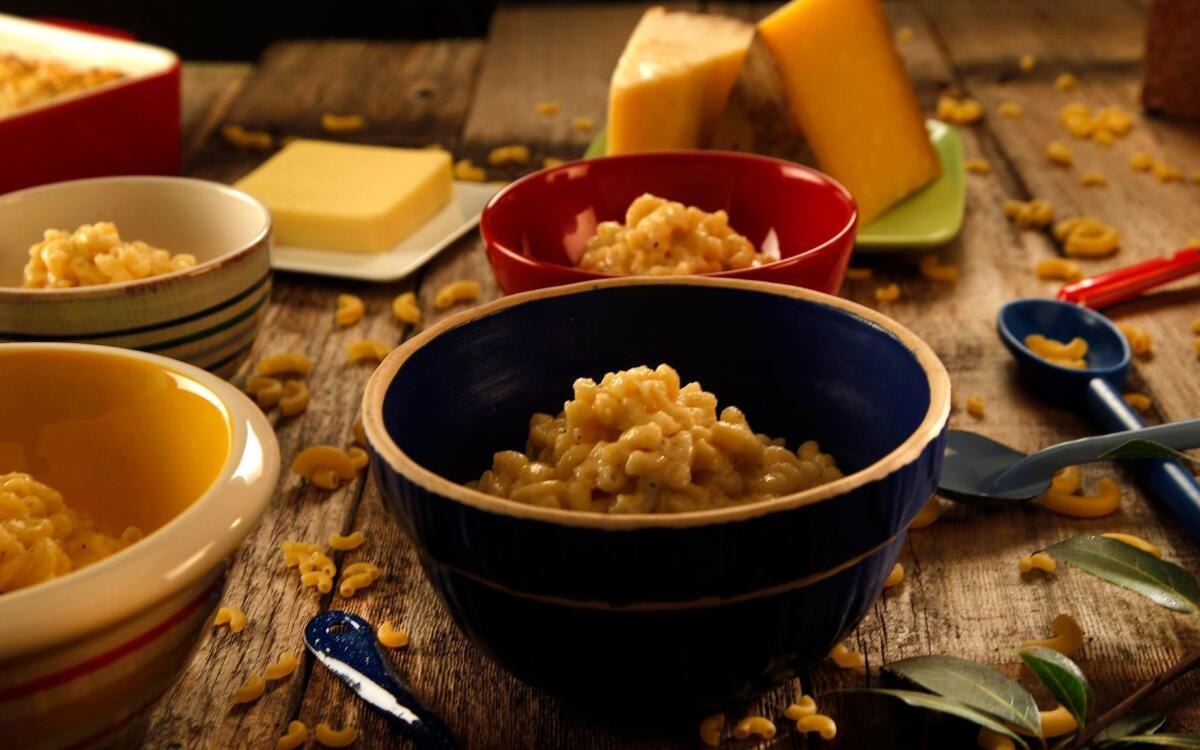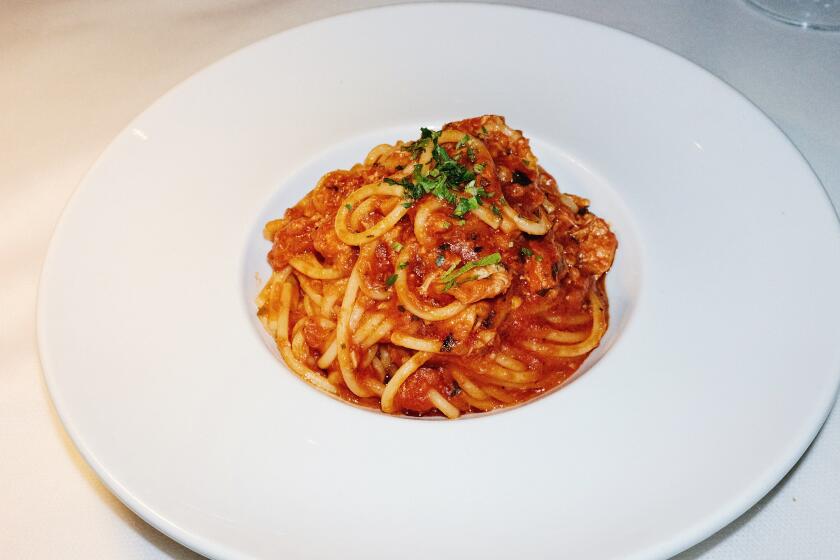Mac and cheese

- Share via
If your household includes children, you likely lost count long ago of the number of bowls of macaroni and cheese you’ve made, ordered at restaurants, microwaved or poured out of a box. As if by some collective agreement, the stuff becomes locked into our food psyches from an absurdly early age, the very definition of comfort food.
There’s good reason for this, of course. A bowl of pasta loaded with cheese sauce is a 3-year-old’s version of the crispy baguette and excellent French Camembert that is for some of us a staple food of adulthood. (Some kids jump straight to this. I have happy memories of attending elementary school basketball games with my younger daughter, whose love for ripe cheeses exiled us to the upper bleachers.) And as with many simple recipes, the dish hinges on the quality of its ingredients. Also, if you’re going to make pot after pot of the stuff, it should be good. Most of all? You’ll want your kid to make it as soon as is reasonably possible.
The best reason for making mac and cheese is the cheese itself. As with fondue, a pot of melted cheese sauce is by nature forgiving: You can grate whatever odds and ends you have in your cheese drawer into a pot and they can coalesce into something quite marvelous. But it’s also an occasion to source the good stuff, to turn the production of your dinner into a kind of cheese-plate tasting menu. Head to your local cheesemonger (your kid will appreciate both word and job description) and get some Montgomery’s cheddar from England, or Vermont’s Cabot clothbound cheddar or Hook’s aged cheddar from Wisconsin. If you haven’t tried Gruyère in your mac and cheese, you’re missing out. Nutty and slightly sweet, the Swiss cheese has a complex and highly addictive earthy flavor when aged — and it’s often done in actual caves, something else your kid will appreciate. And if you usually just grate Parmesan over pasta or bowls of spaghetti and meatballs, then you’ll likely enjoy adding it to your cheese sauce; the pungent, salty cheese gives further dimension to the flavors and means you don’t need to add any more salt than what’s in the pasta water.
You can also think of a pot of mac and cheese as an object lesson. If you break down the components, you have a surprisingly extensive tutorial on basic kitchen techniques in the short space between your counter and stove-top. The mound of pasta, for starters, is an occasion to discuss the relationship between sauce and noodle, how the consistency of the former matches with the shape, size and texture of the latter to create a particularly great dish. Imagine mac and cheese made with lasagna, orzo, vermicelli, fideo. No. Then there’s the tragedy of overcooked pasta. If your kid learns how to cook her noodles properly al dente in elementary school, then you have passed on a gift that will last a lifetime.
You can achieve a perfectly creditable mac and cheese without making a roux. My mother went her whole life without making one, just grating Velveeta and then, mercifully, real cheese, into a pot of warm pasta and milk for our dinner. But making a roux is a lot easier than it sounds — you just cook flour and butter for a while. It also sounds pretty impressive. You can then segue naturally into a discussion of mother sauces, and graduate to making béchamel and velouté. Or, if your kid is interested in Cajun and Creole cooking, and why would she not be?, then gumbo and étouffée. Either way, making a roux is fun, does not take long, and can even be slightly meditative once you get the hang of it. When she was younger, my daughter would stare intently at the pan as she whisked, the timer set, to make sure it didn’t burn. Now she reads Victorian novels while she stirs.
The beautiful thing about mac and cheese is that you’re not going to grow out of it. You’ll crave it at odd moments, wanting a soothing pot of it, as one of my daughters prefers it, or preferring it baked until crunchy and golden, as my other daughter likes it. (Do not buy bread crumbs for the baked version if you can help it; instead, use stale baguettes and pulverize them in a food processor.) It’s a dish that migrates from afternoon homework sessions to dorm room kitchens to, some day, maybe more children.
And as your kid’s palette changes, you’ll find that mac and cheese can be dressed up with other stuff (bacon, truffles) and that it is an utterly fantastic conduit for hot sauce. My daughter’s current favorite addition to the basic recipe she’s been making since third grade? A shaker of bhut jolokia salt. I like to think of it as our kitchen version of the American dream: from loaves of Velveeta to ghost chiles, in one generation.
If baking the mac and cheese, heat the oven to 400 degrees and butter a 13- by 9-inch baking or casserole dish.
Meanwhile, bring a large pot of salted water to a boil. Add the macaroni to the water and cook until it is just al dente, stirring occasionally to keep the noodles from sticking together and to the bottom of the pot. Drain the macaroni in a colander, then place into a large bowl and set aside.
In a large saucepan, melt the butter over medium-high heat. When it’s melted, quickly whisk in the flour to keep it from clumping and to form a roux. Reduce the heat and continue to cook the roux, whisking constantly, for two minutes.
Slowly pour in the milk while whisking. Add the pepper and bay leaves. Increase the temperature until the mixture begins to simmer, still whisking, and cook until it thickens to the consistency of heavy cream. Remove from heat and fish out the bay leaves, using a pair of tongs or spoon.
Gradually add the Gruyère and cheddar cheeses, along with 1 cup of Parmesan to the sauce, stirring until the cheese is melted. If the sauce is too thick, whisk in additional milk, a tablespoon or so at a time. When the cheese sauce is smooth, pour it over the bowl of pasta and stir until combined. Serve if desired.
To bake the mac and cheese, spoon the mixture into the baking dish. In a small bowl, combine the bread crumbs with the remaining Parmesan cheese and sprinkle the mixture over the pasta. Bake until the bread crumbs are golden brown and the mac and cheese is bubbly, about 25 to 30 minutes.
Get our Cooking newsletter.
Your roundup of inspiring recipes and kitchen tricks.
You may occasionally receive promotional content from the Los Angeles Times.
















